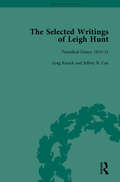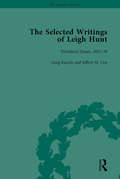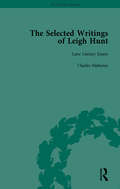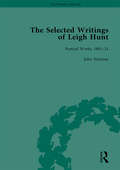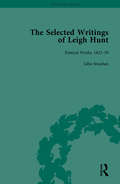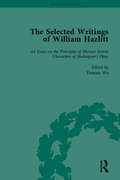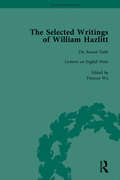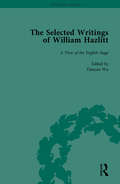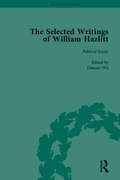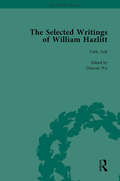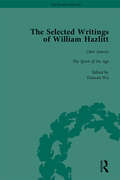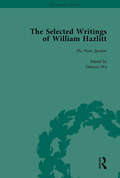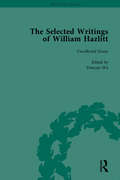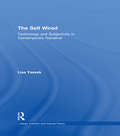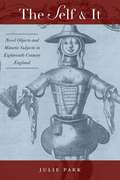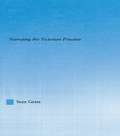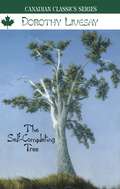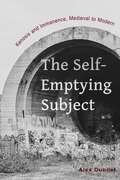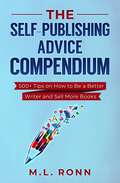- Table View
- List View
The Selected Writings of Andrew Lang: Volume III: Literary Criticism (Routledge Historical Resources)
by Tom HubbardA novelist, poet, literary critic and anthropologist, Andrew Lang is best known for his publications on folklore, mythology and religion; many have grown up with the ‘colour’ Fairy Books which he compiled between 1889 and 1910. This three volume set presents a selection of his work in these areas. The third volume arranges his literary criticism, first by geo-cultural context and then chronologically. It begins with Lang’s views on the nature and purpose of fiction, then presents samples of his work on some of the most important authors in the respective canons of French, American, Scottish and English literature including Victor Hugo, Edgar Allan Poe, Robert Burns and Charles Dickens among many others, mainly of the nineteenth century. Collectively, the General Introduction to the set and the Introductions to the individual volumes offer a thorough overview of Lang’s work in an astonishing variety of fields, including his translation work on Homer and his contributions to historiography (particularly Scottish). The Introduction to Volume III sets Lang within the context of the literature of his times, comparing and contrasting him with significant contemporaries. Headnotes to the individual items are of varying length and provide more detail on specific topics, and explanatory notes supply unique intellectual comment rather than merely factual information.
The Selected Writings of Leigh Hunt Vol 1
by Robert Morrison Michael Eberle-SinatraThis edition makes available in a single edition all of Hunt's major works, fully annotated and with a consolidated index. The set will include all of Hunt's poetry, and an extensive selection of his periodical essays.
The Selected Writings of Leigh Hunt Vol 2
by Robert Morrison Michael Eberle-SinatraThis edition makes available in a single edition all of Hunt's major works, fully annotated and with a consolidated index. The set will include all of Hunt's poetry, and an extensive selection of his periodical essays.
The Selected Writings of Leigh Hunt Vol 3 (The\pickering Masters Ser.)
by Robert Morrison Michael Eberle-SinatraThis edition makes available in a single edition all of Hunt's major works, fully annotated and with a consolidated index. The set will include all of Hunt's poetry, and an extensive selection of his periodical essays.
The Selected Writings of Leigh Hunt Vol 4
by Robert Morrison Michael Eberle-SinatraThis edition makes available in a single edition all of Hunt's major works, fully annotated and with a consolidated index. The set will include all of Hunt's poetry, and an extensive selection of his periodical essays.
The Selected Writings of Leigh Hunt Vol 5
by Robert Morrison Michael Eberle-SinatraThis edition makes available in a single edition all of Hunt's major works, fully annotated and with a consolidated index. The set will include all of Hunt's poetry, and an extensive selection of his periodical essays.
The Selected Writings of Leigh Hunt Vol 6
by Robert Morrison Michael Eberle-SinatraThis edition makes available in a single edition all of Hunt's major works, fully annotated and with a consolidated index. The set will include all of Hunt's poetry, and an extensive selection of his periodical essays.
The Selected Writings of William Hazlitt Vol 1
by David Bromwich Duncan Wu Tom Paulin Stanley Jones Roy ParkWilliam Hazlitt is viewed by many as one of the most distinguished of the non-fiction prose writers to emerge from the Romantic period. This nine-volume edition collects all his major works in complete form.
The Selected Writings of William Hazlitt Vol 2 (The\pickering Masters Ser.)
by David Bromwich Duncan Wu Tom Paulin Stanley Jones Roy ParkWilliam Hazlitt is viewed by many as one of the most distinguished of the non-fiction prose writers to emerge from the Romantic period. This nine-volume edition collects all his major works in complete form.
The Selected Writings of William Hazlitt Vol 3
by David Bromwich Duncan Wu Tom Paulin Stanley Jones Roy ParkWilliam Hazlitt is viewed by many as one of the most distinguished of the non-fiction prose writers to emerge from the Romantic period. This nine-volume edition collects all his major works in complete form.
The Selected Writings of William Hazlitt Vol 4
by David Bromwich Duncan Wu Tom Paulin Stanley Jones Roy ParkWilliam Hazlitt is viewed by many as one of the most distinguished of the non-fiction prose writers to emerge from the Romantic period. This nine-volume edition collects all his major works in complete form.
The Selected Writings of William Hazlitt Vol 5 (The\pickering Masters Ser.)
by David Bromwich Duncan Wu Tom Paulin Stanley Jones Roy ParkWilliam Hazlitt is viewed by many as one of the most distinguished of the non-fiction prose writers to emerge from the Romantic period. This nine-volume edition collects all his major works in complete form.
The Selected Writings of William Hazlitt Vol 6
by David Bromwich Duncan Wu Tom Paulin Stanley Jones Roy ParkWilliam Hazlitt is viewed by many as one of the most distinguished of the non-fiction prose writers to emerge from the Romantic period. This nine-volume edition collects all his major works in complete form.
The Selected Writings of William Hazlitt Vol 7 (The\pickering Masters Ser.)
by David Bromwich Duncan Wu Tom Paulin Stanley Jones Roy ParkWilliam Hazlitt is viewed by many as one of the most distinguished of the non-fiction prose writers to emerge from the Romantic period. This nine-volume edition collects all his major works in complete form.
The Selected Writings of William Hazlitt Vol 8
by David Bromwich Duncan Wu Tom Paulin Stanley Jones Roy ParkWilliam Hazlitt is viewed by many as one of the most distinguished of the non-fiction prose writers to emerge from the Romantic period. This nine-volume edition collects all his major works in complete form.
The Selected Writings of William Hazlitt Vol 9
by David Bromwich Duncan Wu Tom Paulin Stanley Jones Roy ParkWilliam Hazlitt is viewed by many as one of the most distinguished of the non-fiction prose writers to emerge from the Romantic period. This nine-volume edition collects all his major works in complete form.
The Self Wired: Technology and Subjectivity in Contemporary Narrative (Literary Criticism and Cultural Theory)
by Lisa YaszekFirst Published in 2002. Routledge is an imprint of Taylor & Francis, an informa company.
The Self and It
by Julie ParkObjects we traditionally regard as "mere" imitations of the human-dolls, automata, puppets-proliferated in eighteenth-century England's rapidly expanding market culture. During the same period, there arose a literary genre called "the novel" that turned the experience of life into a narrated object of psychological plausibility. Park makes a bold intervention in histories of the rise of the novel by arguing that the material objects abounding in eighteenth-century England's consumer markets worked in conjunction with the novel, itself a commodity fetish, as vital tools for fashioning the modern self. As it constructs a history for the psychology of objects,The Self and Itrevises a story that others have viewed as originating later: in an age of Enlightenment, things have the power to move, affect people's lives, and most of all, enable a fictional genre of selfhood. The book demonstrates just how much the modern psyche-and its thrilling projections of "artificial life"-derive from the formation of the early novel, and the reciprocal activity between made things and invented identities that underlie it.
The Self and Its Pleasures: Bataille, Lacan, and the History of the Decentered Subject
by Carolyn J. DeanWhy did France spawn the radical poststructuralist rejection of the humanist concept of ‘man’ as a rational, knowing subject? In this innovative cultural history, Carolyn J. Dean sheds light on the origins of poststructuralist thought, paying particular attention to the reinterpretation of the self by Jacques Lacan, Georges Bataille, and other French thinkers. Arguing that the widely shared belief that the boundaries between self and other had disappeared during the Great War helps explain the genesis of the new concept of the self, Dean examines an array of evidence from medical texts and literary works alike. The Self and Its Pleasures offers a pathbreaking understanding of the boundaries between theory and history.
The Self in the Cell: Narrating the Victorian Prisoner (Literary Criticism and Cultural Theory)
by Sean C. GrassMichel Foucault's writing about the Panopticon in Discipline and Punish has dominated discussions of the prison and the novel, and recent literary criticism draws heavily from Foucauldian ideas about surveillance to analyze metaphorical forms of confinement: policing, detection, and public scrutiny and censure. But real Victorian prisons and the novels that portray them have few similarities to the Panopticon. Sean Grass provides a necessary alternative to Foucault by tracing the cultural history of the Victorian prison, and pointing to the tangible relations between Victorian confinement and the narrative production of the self. The Self in the Cell examines the ways in which separate confinement prisons, with their demand for autobiographical production, helped to provide an impetus and a model that guided novelists' explorations of the private self in Victorian fiction.
The Self-Completing Tree
by Dorothy LivesayThe Self-Completing Tree is the author’s own collection of the best of her last 50 years of writing. In this new edition, the celebrated Grand Dame of English Canadian letters and award-winning poet uses the metaphor implied by the title — a tree, half verdant, half in flames — to symbolize the androgynous self. This is the theme of much of Livesay’s work and a central metaphor for the most definitive collection of her poetry. The result is a spiritual autobiography charting the fascinating domains of her own life and the universal struggles we all share.
The Self-Dismembered Man: Selected Later Poems of Guillaume Apollinaire (French Edition) (Wesleyan Poetry Series)
by Guillaume ApollinaireGuillaume Apollinaire's final years exactly coincided with the clamorous advent of European Modernism and with the cataclysms of WWI. In The Self-Dismembered Man, poet Donald Revell offers new English translations of the most powerful poems Apollinaire wrote during those years: poems of nascent surrealism, of combat and of war-weariness. Here, too, is Apollinaire's last testament, "The Pretty Redhead," a farewell to the epoch that he—as poet, convict, art-critic, artilleryman and boulevardier—did so much to conjure and sustain until his death on Armistice Day in 1918. Readers of Apollinaire's more familiar early work, Alcools (Wesleyan, 1995), will find here a darker and yet more tender poet, a poet of the broken world who shares entirely the world's catastrophe even as he praises to the end its glamour and its strange innocence. This English translation, facing the original French, illuminates Apollinaire's crucial and continuing influence on the European and American avant-garde. The volume includes a short translator's preface.
The Self-Emptying Subject: Kenosis and Immanence, Medieval to Modern
by Alex DubiletAgainst the two dominant ethical paradigms of continental philosophy–Emmanuel Levinas’s ethics of the Other and Michel Foucault’s ethics of self-cultivation—The Self-Emptying Subject theorizes an ethics of self-emptying, or kenosis, that reveals the immanence of an impersonal and dispossessed life “without a why.” Rather than aligning immanence with the enclosures of the subject, The Self-Emptying Subject engages the history of Christian mystical theology, modern philosophy, and contemporary theories of the subject to rethink immanence as what precedes and exceeds the very difference between the (human) self and the (divine) other, between the subject and transcendence. By arguing that transcendence operates and subjects life in secular no less than in religious domains, this book challenges the dominant distribution of concepts in contemporary theoretical discourse, which insists on associating transcendence exclusively with religion and theology and immanence exclusively with modern secularity and philosophy.The Self-Emptying Subject argues that it is important to resist framing the relationship between medieval theology and modern philosophy as a transition from the affirmation of divine transcendence to the establishment of autonomous subjects. Through an engagement with Meister Eckhart, G.W.F. Hegel, and Georges Bataille, it uncovers a medieval theological discourse that rejects the primacy of pious subjects and the transcendence of God (Eckhart); retrieves a modern philosophical discourse that critiques the creation of self-standing subjects through a speculative re-writing of the concepts of Christian theology (Hegel); and explores a discursive site that demonstrates the subjecting effects of transcendence across theological and philosophical operations and archives (Bataille). Taken together, these interpretations suggest that if we suspend the antagonistic relationship between theological and philosophical discourses, and decenter our periodizing assumptions and practices, we might encounter a yet unmapped theoretical fecundity of self-emptying that frees life from transcendent powers that incessantly subject it for their own ends.
The Self-Help Compulsion: Searching for Advice in Modern Literature
by Beth BlumSamuel Beckett as a guru for business executives? James Joyce as a guide to living a good life? The notion of notoriously experimental authors sharing a shelf with self-help books might seem far-fetched, yet a hidden history of rivalry, influence, and imitation links these two worlds. In The Self-Help Compulsion, Beth Blum reveals the profound entanglement of modern literature and commercial advice from the late nineteenth century to the present day.Blum explores popular reading practices in which people turn to literature in search of practical advice alongside modern writers’ rebukes of such instrumental purposes. As literary authors positioned themselves in opposition to people like Samuel Smiles and Dale Carnegie, readers turned to self-help for the promises of mobility, agency, and practical use that serious literature was reluctant to supply. Blum unearths a series of unlikely cases of the love-hate relationship between serious fiction and commercial advice, from Gustave Flaubert’s mockery of early DIY culture to Dear Abby’s cutting diagnoses of Nathanael West and from Virginia Woolf’s ambivalent polemics against self-improvement to the ways that contemporary global authors such as Mohsin Hamid and Tash Aw explicitly draw on the self-help genre. She also traces the self-help industry’s tendency to popularize, quote, and adapt literary wisdom and considers what it might have to teach today’s university. Offering a new history of self-help’s origins, appeal, and cultural and literary import around the world, this book reveals that self-help’s most valuable secrets are not about getting rich or winning friends but about how and why people read.
The Self-Publishing Advice Compendium: 500+ Tips on How to Be a Better Writer and Sell More Books (Author Level Up #9)
by M.L. RonnNeed some writing advice? This gargantuan book offers 500+ practical and concise tips to help you with writing, publishing, and marketing your book. The tips are inspired by the popular podcast, “Writing Tip of the Day,” hosted by M.L. Ronn (the author). It contains lessons he learned after writing over 60 books. From 2019-2021, writers all over the world started their day with M.L. Ronn's advice, and now you can, too. In this book, you’ll learn: How to write magnetic prose How to navigate your book’s murky middle Sneaky marketing tips How to take care of your mental health Tax tips for writers And much more! These writing tips will help you finish your next book with confidence. The writing life won't seem so hard when you're done reading. Are you ready to supercharge your writing career? V1.0


